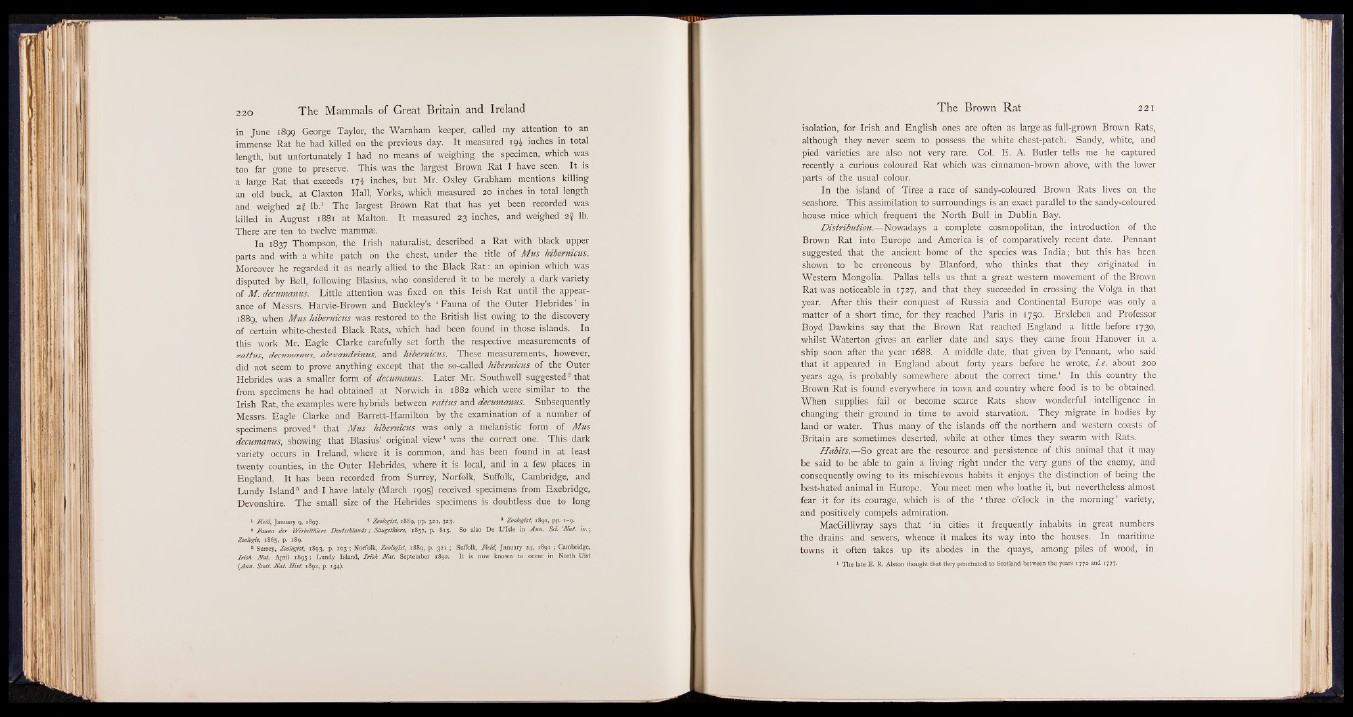
in June 1899 George Taylor, the Warnham keeper, called my attention to an
immense Rat he had killed on the previous day. It measured I 9 i inches in total
length, but unfortunately I had no means Of weighing the specimen, which was
too far gone to preserve. This was the largest Brown Rat I have seen. It is
a large Rat that exceeds 1 7 J inches, but Mr. Oxley Grabham mentions killing
an old buck, at Claxton Hall, Yorks, which measured 20 inches in total length
and weighed 2 f lb.1 The largest Brown Rat that has yet been recorded was
killed in August 1881 at Malton. It measured 23 inches, and weighed 2 | lb.
There are ten to twelve mammae.
In 1837 Thompson, the Irish naturalist, described a Rat with black upper
parts and with a white patch on the chest, under the title of Mus hibernicus.
Moreover he regarded it as nearly allied to the Black R a t : an opinion which was
disputed by Bell, .following Blasius, who considered it to be merely a dark variety
of M. decumanus. Little attention was fixed on this Irish Rat until the appearance
of Messrs. Harvie-Brown and Buckley's < Fauna of the Outer Hebrides' in
1889, when Mus hibernicus was restored to the British list owing to the discovery
of certain white-chested Black Rats, which had been found in those islands. In
this work Mr. Eagle Clarke carefully set forth the respective measurements of
rattus, decumanus, alexandrinus, and hibernicus. These measurements, however,
did not seem to prove anything except that the so-called hibernicus of the Outer
Hebrides was a smaller form of decumanus. Later Mr. Southwell suggested2 that
from specimens he had obtained at Norwich in 1882 which were similar, to the
Irish Rat, the examples were hybrids between rattu s and decumanus. Subsequently
Messrs. Eagle Clarke and Barrett-Hamilton by the examination of a number of
specimens proved8 that Mus hibernicus was only a melanistic form of M ils
decumanus, showing that Blasius’ original view* was the correct one.; This dark
variety occurs in Ireland, where it is common, and has been found in at least
twenty counties, in the Outer Hebrides, where it is local, and in a few places in
England. It has been recorded from Surrey, Norfolk, Suffolk, Cambridge, and
Lundy Island* and I have lately (March 1905) received specimens from Exebridge,
Devonshire. The small size of the Hebrides specimens is doubtless due to long
1 Field, January 9, 1897. 2 Zoologist, 1889, pp. 321, 323. 3 Zoologist, 1891, pp. 1-9.
4 Fauna der Wirbelthiere Deutschlands; Sdugethiere, 1857, p. 815. So also De L’Isle in Ann. Sci. 'Nat. iv.;
Zoologie, 1865, p. 189.
5 Surrey, Zoologist, 1893, p. 103 ; Norfolk, Zoologist, 1889, p. 321 ; Suffolk, Field, January 24, 1891 ; Cambridge,
Irish Nat. April 1895 j Lundy Island, Irish Nat. September 1892. It is now known to occur in North Uist
(Ann. Scott. Nat. Hist. 1892, p. 134).
isolation, for Irish and English ones are often as large as full-grown Brown Rats,
although they never seem to possess the white chest-patch. Sandy, white, and
pied varieties are also not very rare. Col. E. A. Butler tells me he captured
recently a curious coloured Rat which was cinnamon-brown above, with the lower
parts of the usual colour.
In the island of Tiree a race of sandy-coloured Brown Rats lives on the
seashore. This assimilation to surroundings is an exact parallel to the sandy-coloured
house mice which frequent the North Bull in Dublin Bay.
D istribution.—Nowadays a complete cosmopolitan, the introduction of the
Brown Rat into Europe and America is of comparatively recent date. Pennant
suggested that the ancient home of the species was India; but this has been
shown to be erroneous by Blanford, who thinks that they originated in
Western Mongolia. Pallas tells us that a great western movement of the Brown
Rat was noticeable in 1727, and that they succeeded in crossing the Volga in that
year. After this their conquest of Russia and Continental Europe was only a
matter of a short time, for they reached Paris in 1750. Erxleben and Professor
Boyd Dawkins say that the Brown Rat reached England a little before 1730,
whilst Waterton gives an earlier date and says they came from Hanover in a
ship soon after the year 1688. A middle date, that given by Pennant, who said
that it appeared in England about forty years before he wrote, i.e. about 200
years ago, is probably somewhere about the correct time.1 In this country the
Brown Rat is found everywhere in town and country where food is to be obtained.
When supplies fail or become scarce Rats show wonderful intelligence in
changing their ground in time to avoid starvation. They migrate in bodies by
land or water. Thus many of the islands off the northern and western coasts of
•Britain are sometimes deserted, while at other times they swarm with Rats.
H abits.—So great are the resource and persistence of this animal that it may
be said to be able to gain a living right under the very guns of the enemy, and
consequently owing to its mischievous habits it enjoys the distinction of being the
best-hated animal in Europe. You meet men who loathe it, but nevertheless almost
fear it for its courage, which is of the * three o’clock in the morning ’ variety,
and positively compels admiration.
MacGillivray says that ‘ in cities it frequently inhabits in great numbers
the drains and sewers, whence it makes its way into the houses. In maritime
towns it often takes up its abodes in the quays, among piles of wood, in
1 The late E. R. Alston thought that they penetrated to Scotland between the years 1770 and 1777.